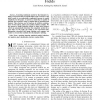Free Online Productivity Tools
i2Speak
i2Symbol
i2OCR
iTex2Img
iWeb2Print
iWeb2Shot
i2Type
iPdf2Split
iPdf2Merge
i2Bopomofo
i2Arabic
i2Style
i2Image
i2PDF
iLatex2Rtf
Sci2ools
PAMI
2008
2008
Learning Flexible Features for Conditional Random Fields
Abstract-- Extending traditional models for discriminative labeling of structured data to include higher-order structure in the labels results in an undesirable exponential increase in model complexity. In this paper, we present a model that is capable of learning such structures using a random field of parameterized features. These features can be functions of arbitrary combinations of observations, labels and auxiliary hidden variables. We also present a simple induction scheme to learn these features, which can automatically determine the complexity needed for a given data set. We apply the model to two real-world tasks, information extraction and image labeling, and compare our results to several other methods for discriminative labeling.
Auxiliary Hidden Variables | Discriminative Labeling | PAMI 2008 | Undesirable Exponential Increase |
| Added | 14 Dec 2010 |
| Updated | 14 Dec 2010 |
| Type | Journal |
| Year | 2008 |
| Where | PAMI |
| Authors | Liam Stewart, Xuming He, Richard S. Zemel |
Comments (0)

